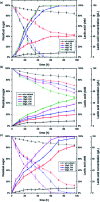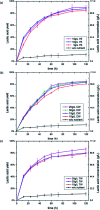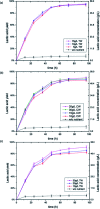Nutrient value of fish manure waste on lactic acid fermentation by Lactobacillus pentosus
- PMID: 35548205
- PMCID: PMC9085642
- DOI: 10.1039/c8ra06142d
Nutrient value of fish manure waste on lactic acid fermentation by Lactobacillus pentosus
Abstract
The aim of this work was to study the feasibility of using fish manure waste as a nutrient source for lactic acid fermentation. Fish waste contains nitrogen and minerals that could support the growth of lactic acid bacteria (LAB), making it a good candidate as the nutrient source for lactic acid fermentation. Two different fish manure wastes, from Nile tilapia and channel catfish aquaculture, were investigated for their performance on different sugar substrates. Both fish waste types showed low efficiency in the direct fermentation of glucose, but satisfactory efficiencies in simultaneous saccharification and fermentation (SSF) of cellulosic materials, such as pure cellulose and paper sludge. The highest lactic acid yield obtained was 87% and 91%, with a corresponding volumetric productivity of 1.006 and 0.580 g L-1 h-1, and corresponding lactic acid concentration of 96 and 56 g L-1 for cellulose and paper sludge, respectively. Fish waste concentrations did not show much impact on lactic acid production for the SSF process, where increasing fish waste from 10 to 30 g L-1 resulted in less than a 10% yield increase. In the present study, fish manure waste was shown to be an effective and economic nutrient source for lactic acid production by SSF.
This journal is © The Royal Society of Chemistry.
Conflict of interest statement
There are no conflicts to declare.
Figures



Similar articles
-
Utilization of solid catfish manure waste as carbon and nutrient source for lactic acid production.Appl Microbiol Biotechnol. 2018 Jun;102(11):4765-4772. doi: 10.1007/s00253-018-8985-6. Epub 2018 Apr 19. Appl Microbiol Biotechnol. 2018. PMID: 29675802
-
Production of lactic acid from paper sludge by simultaneous saccharification and fermentation.Adv Biochem Eng Biotechnol. 2004;87:173-94. doi: 10.1007/b94365. Adv Biochem Eng Biotechnol. 2004. PMID: 15217107 Review.
-
Lactic acid production from food waste hydrolysate by Lactobacillus pentosus: Focus on nitrogen supplementation, initial sugar concentration, pH, and fed-batch fermentation.J Food Sci. 2022 Jul;87(7):3071-3083. doi: 10.1111/1750-3841.16205. Epub 2022 Jun 6. J Food Sci. 2022. PMID: 35669993
-
Production of lactic acid from food wastes.Appl Biochem Biotechnol. 2003 Spring;105 -108:637-47. doi: 10.1385/abab:107:1-3:637. Appl Biochem Biotechnol. 2003. PMID: 12721443
-
Upflow anaerobic sludge blanket reactor--a review.Indian J Environ Health. 2001 Apr;43(2):1-82. Indian J Environ Health. 2001. PMID: 12397675 Review.
Cited by
-
Bioconversion of Fish Discards through the Production of Lactic Acid Bacteria and Metabolites: Sustainable Application of Fish Peptones in Nutritive Fermentation Media.Foods. 2020 Sep 4;9(9):1239. doi: 10.3390/foods9091239. Foods. 2020. PMID: 32899847 Free PMC article.
-
Food packaging wastes amid the COVID-19 pandemic: Trends and challenges.Trends Food Sci Technol. 2021 Oct;116:1195-1199. doi: 10.1016/j.tifs.2021.05.027. Epub 2021 Jun 1. Trends Food Sci Technol. 2021. PMID: 34092920 Free PMC article.
-
Characterization of Lactic Acid Bacteria Isolated From Rotting Oranges and Use of Agropastoral Processing By-products as Carbon and Nitrogen Sources Alternative for Lactic Acid Production.Biomed Res Int. 2024 Sep 9;2024:4264229. doi: 10.1155/2024/4264229. eCollection 2024. Biomed Res Int. 2024. PMID: 39286282 Free PMC article.
References
-
- Tsuji H., Bio-based plastics: materials and applications, 2013, pp. 171–239
-
- Jem K. J., van der Pol J. F. and de Vos S., in Plastics from bacteria, Springer, 2010, pp. 323–346
LinkOut - more resources
Full Text Sources
Miscellaneous

